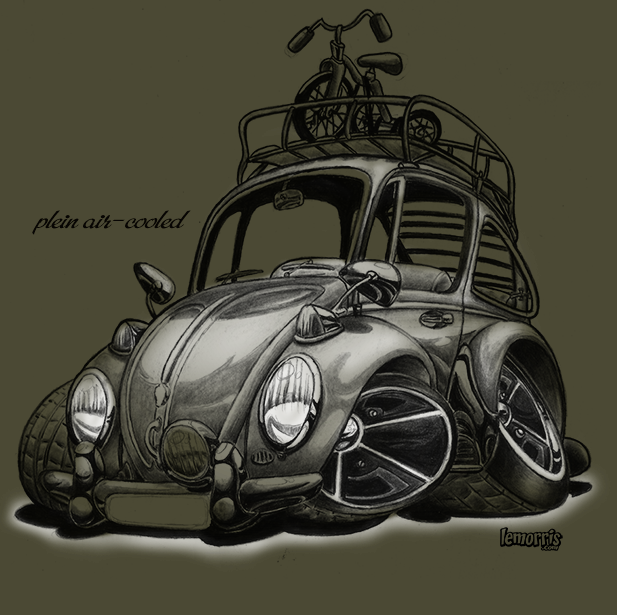I
SAW HIS EXCELLENCY TODAY
I
saw his excellency
Today.
In a motorcade
Of scavengers.
His opulence
Greeted my squaloid,
With fingers
Corrupted with leprosy.
Though I saw no evil
And heard no evil,
Their faces
Wore manuscripts of taboos.
He spoke phonetics,
Impaired and acoustic,
His throat throttling,
Like a knocked out beetle engine.
Today.
In a motorcade
Of scavengers.
His opulence
Greeted my squaloid,
With fingers
Corrupted with leprosy.
Though I saw no evil
And heard no evil,
Their faces
Wore manuscripts of taboos.
He spoke phonetics,
Impaired and acoustic,
His throat throttling,
Like a knocked out beetle engine.

Plein Air-Cooled -- Lemorris
Adolf Hitler wanted a cheap, simple car to be mass-produced for Germany’s new road network, the Reichsautobahn. In 1934 he contacted Ferdinand Porsche to design and build a “people’s car” (Volkswagen); in 1931 Porsche had developed an Auto für Jedermann ("car for everyone") for the motorcycle manufacturer Zündapp. Hitler also urged “the Great German Engineer” to abandon his Czech citizenship and become German; in 1937, Porsche joined the National Socialist German Workers' Party (the Nazis) and the paramilitary SS (Schutzstaffel, Protection Squadron); by 1938, he was using the SS as security members and drivers at his factory, later he set up a special unit called SS Sturmwerk Volkswagen, and in 1942 was promoted to the rank of SS-Oberführer (approximately the same as a senior colonel or a British brigadier). The first two VW prototypes were completed in 1935, followed by several more pre-production batches from 1936 to 1939. A new city, "Stadt des KdF-Wagens" (modern Wolfsburg) was founded in 1938 near Fallersleben, Niedersachsen (Lower Saxony) for the Volkswagen factory, after Italian labor was brought in. During the war the factory relied on forced labor; German nationals only made up 10% of its workforce at the end of World War II. Wartime production concentrated almost exclusively on the military Kübelwagen and Schwimmwagen variants. In November 1945, after World War II, Porsche was asked to continue the design of the Volkswagen in France and to move the factory equipment there as part of war reparations, but the next month French authorities arrested him as a war criminal; he was imprisoned in Baden-Baden, Paris, and Dijon. Mass production of the “Käfer” (beetle) began after the war. Outside of Germany it was usually marketed as the Volkswagen (in France it was the Coccinelle, “ladybug”). The “bug” is the longest-running and most-manufactured car of a single platform ever made, with 21,529,464 produced. In 1974 it was superseded by the Golf (known as the Rabbit in the US and Canada, as the Caribe in Mexico). In 1994 the company unveiled the Concept One, a retro-themed auto resembling the original, designed by J. Mays and Freeman Thomas at the company's California design studio, and in 1998 it introduced the "New Beetle,” built on the contemporary Golf platform but with styling that recalled the original Type 1, which was replaced in 2011 by the more aggressively styled Beetle (A5), which was also reminiscent of the old Beetle but was built on a Jetta platform.
ReplyDelete